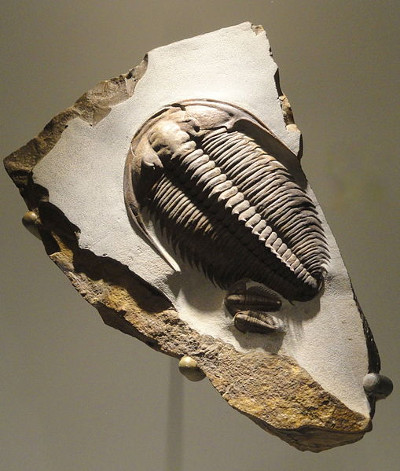The Cambrian period is the first period of the Paleozoic era. It lasted from about 540 million years ago to 485 million years ago. This period is marked by an explosion of biological diversity representing a significant step forward in the evolution of life on earth.
While very few fossilized animals that lived before this time have been found, a profusion of clear, easily recognizable animal fossils suddenly appeared during the Cambrian, including fossils from most of the animal groups alive today.

Scientists believe that, prior to the Cambrian, animals had simple, soft bodies that decayed before they could fossilize. During the Cambrian, numerous species developed skeletons and hard parts capable of fossilizing. This sudden profusion of more advanced and varied physical forms is referred to as the “Cambrian explosion.”
One such species is the trilobite, an arthropod that ranged from a millimeter to over two feet (0.6 meters) in length. Fossils of their flat, segmented bodies are common. Anamalocaris was an unusual, crustacean-like predator that grew up to 6 feet (2 meters) long. In its day, it was the largest creature on Earth. Crustaceans, annelids (ringed worms) and brachiopods (bottom-dwelling sea creatures with an upper and lower shell, such as clams and mussels) also appeared during the Cambrian.
Scientists aren’t sure what caused this sudden burst of life. Cyanobacteria and algae may finally have released enough oxygen into the atmosphere to fuel more biological complexity. A warming climate is another possible explanation.
During this time, large areas of what is now North America were covered by shallow seas, which may have provided the right environment for evolutionary experimentation. When the marine creatures died, they fell to the bottom and were deposited in sediments, fossilized, and compressed into sedimentary rock.
Rock layers formed during the Cambrian are exposed at the surface in locations across the globe, including the United States, Turkey, Iran, and Yunnan Province, China. The most famous Cambrian fossil site is the Burgess Shale, which is located in British Columbia, Canada. Discovered in 1909, the site is a virtual gold mine of well-preserved invertebrate fossils showing the soft parts of animals that flourished during the Cambrian period. The period ended with a mass extinction event.